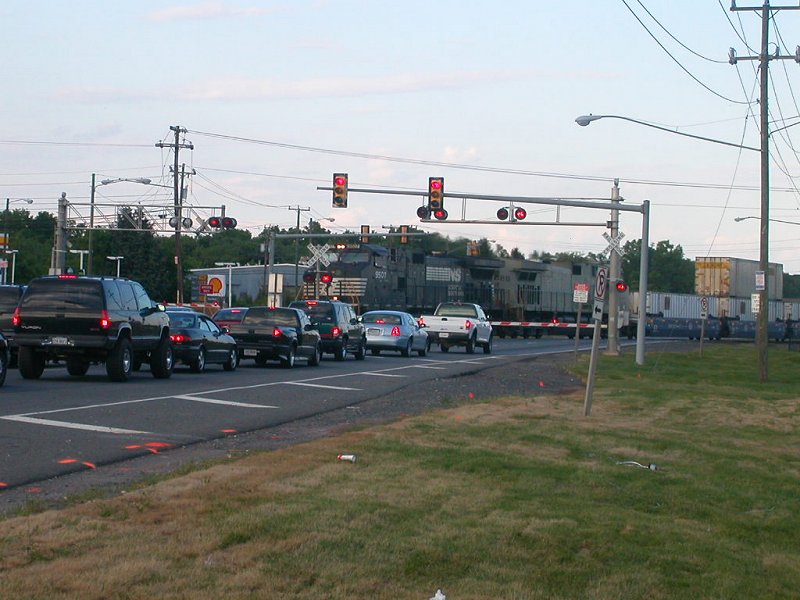
Level of Service (LOS) F on I-66 at Centreville
Questions to Explore This Week
- what are the various transportation plans in Northern Virginia, and how do they differ?
- why was the Northern Virginia Transportation Authority created?
- how does Metro shape land use?
- what is the future of long-distance intercity rail for Northern Virginia?
- what is the future of a rail line around the Beltway in Northern Virginia?
NOTE: We'll cover VRE next week in the "case study" of Prince William County, and discuss Metro to Dulles on listserver

1) Transportation Planning in Northern Virginia
- About COG and member jurisdictions (who's missing?)
- A Citizens Guide To Transportation Decision-Making in the Washington Metropolitan Region (lots of pages, but take a look at the size of the print
- 2002 Transportation Referendum in Northern Virginia
- Virginia Department of Transportation (VDOT)
- Northern Virginia Transportation Authority: FAQ's and The NVTA and Implementation of HB 3202
- Long-Feeble N. Virginia Panel Finds Itself Suddenly Empowered (state funds to finance construction are expected to be exhausted by 2016 - 100% of state funding would be dedicated to maintaining existing infrastructure, putting financial burden for new projects on NVTA and on local voters in counties/cities, who can approve use of local tax dollars for transportation bonds)
- TransAction2030 summary
- How Transportation Funds Are Allocated
- MWCOG Transportation Planning Activities
- City of Fairfax Transportation Planning
- Transportation Nuggets (note in particular the solutions to traffic congestion provided by Anthony Downs)
- Bacions Rebellion: Anatomy of a Bottleneck: The US Route 29/Interstate 66 Interchange in Gainesville, VA for a a strong opinion of the relationship between land use planning and the costs/feasibility of expanding transpoortation infrastructure (think Anthony Downs and Ed Risse would see eye-to-eye?)
2) Metro in Northern Virginia, and read
- Building the Washington Metro
- The Decision to Build, 1946-1965
- The Adopted Regional System, 1966-1968
- Revisions, 1969-2001
- Real Estate
- The Future of Metro
- plus Arlington County, Virginia - National Award for Smart Growth Achievement - 2002 Winners Presentation and 30 Years of Smart Growth: Arlington County's Experience with Transit Oriented Development in the Rosslyn-Ballston Metro Corridor
3) For a perspective on "Rail to Dulles," read
- Bacon's Rebellion: Rail-to-Dulles Realities for a strong opinion of the cost-effectiveness of investing in that project (and note the date it was published)
- Bacon's Rebellion: The Commuting Problem for a strong opinion challenging the assumption that we can ever build enough transportation infrastructure to offer an "easy commute" from the suburbs
(We'll discuss more via listserver...)
4) Amtrak in Virginia
- Read Bacon's Rebellion: Forget Passenger Rail (December 10, 2007) for a strong opinion of the cost-effectiveness of investing in intercity passenger rail
6) Read Capital Beltway Corridor Rail Feasibility Study, to "identify the most feasible means of running rapid transit
between Springfield and Tysons Corner and beyond to Maryland"
- examined heavy rail (such as Metro), light rail, monorail (suspended monobeam), and bus rapid transit (BRT) modes of transit
- was transit through Annandale considered?
- based on the most feasible technology proposed for further study on the Blue Corridor generally paralleling the Capital Beltway, would a "mode shift" be required to get from Springfield to Falls Church (check the map of existing Metro, to be sure you understand where Falls Church is located)?
- of 70,000 to 87,000 total transit riders, how many would be "new" riders pulled away from cars vs. existing transit riders getting a more-convenient trip?
